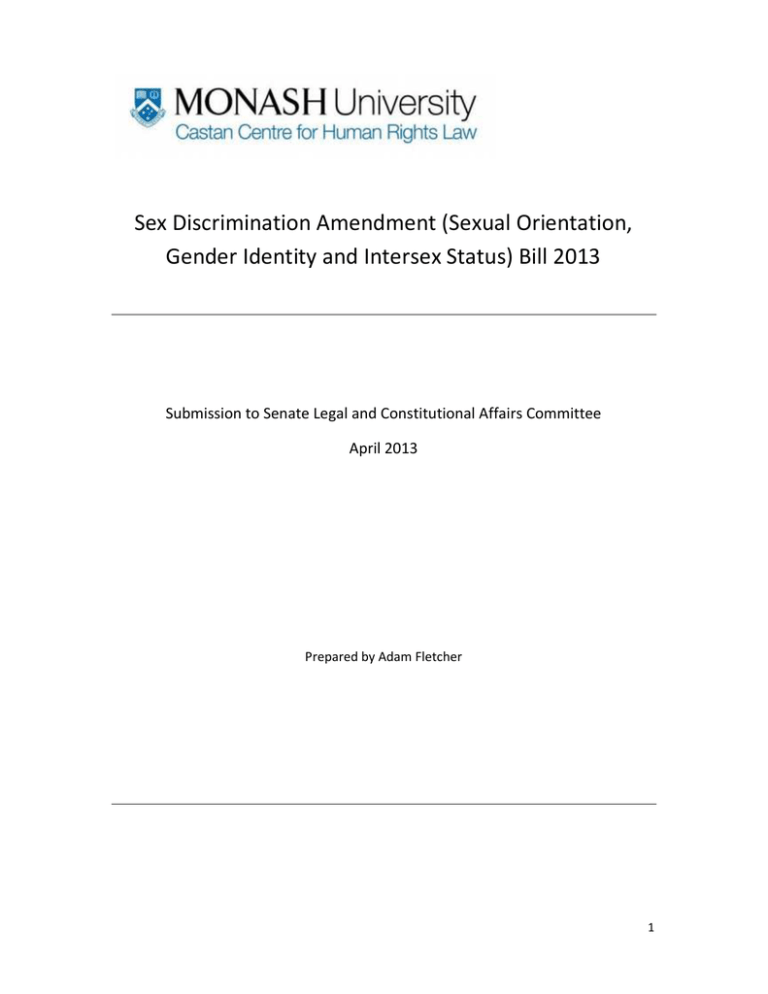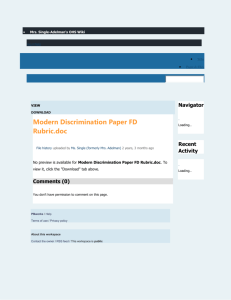Sex Discrimination Amendment (Sexual Orientation, Prepared by Adam Fletcher
advertisement

Sex Discrimination Amendment (Sexual Orientation, Gender Identity and Intersex Status) Bill 2013 Submission to Senate Legal and Constitutional Affairs Committee April 2013 Prepared by Adam Fletcher 1 Introduction/Summary The Castan Centre for Human Rights Law would like to thank the Committee for this opportunity to comment on the Sex Discrimination Amendment (Sexual Orientation, Gender Identity and Intersex Status) Bill 2013. In its submission last year to this Committee on the Exposure Draft of the Human Rights and Anti-discrimination Bill 2012 (the Consolidation Bill),1 the Centre recommended several amendments to the Bill. However, with the exception of proposed clause 19(2)(b), none of these amendments were ‘red-line’ issues which should have prevented the Bill’s expeditious introduction and passage. Be that as it may, it is now apparent that the Bill is to be delayed while the issues identified by the Committee’s inquiry are addressed. In the meantime, the present Bill would make changes to the Sex Discrimination Act 1984 (SDA). The Centre does not deny the urgency of these reforms, which follow numerous national and international recommendations (outlined below). Indeed, our submissions to the Attorney-General’s Department2 and the Committee on the Consolidation Bill reflect our strong support for measures to extend protection against discrimination to the grounds of sexual orientation, gender identity and intersex status. The Centre also supports the extension of coverage to ‘marital or relationship status.’ The Committee has stated that “[i]n light of its recent broad-ranging inquiry into the Exposure Draft of the Human Rights and Anti-Discrimination Bill 2012, the committee will not be focussing on issues which go beyond the scope of the Bill.”3 Given this, we will confine our recommendation in this submission to support for the Bill’s passage, subject to the reservations set out below. Nevertheless, we would like to register our disappointment at the Government’s apparently indefinite postponement of the introduction of the Consolidation Bill.4 We hope that the present amendments will be Parliament’s first step toward addressing the wider shortcomings of Australia’s anti-discrimination law as identified in the course of the AttorneyGeneral’s Department’s Consolidation Project consultation process. 1 See Human Rights and Anti-discrimination Bill 2012 – Exposure Draft: Submission to Senate Legal and Constitutional Affairs Committee, December 2012, available at: <http://www.law.monash.edu.au/castancentre/policywork/anti-disc-sub.pdf>. 2 Consolidation of Anti-discrimination Laws: Submission to Australian Government Attorney-General’s Department, January 2012: <http://law.monash.edu.au/castancentre/publications/consolidation-of-adlaws.pdf>. 3 See Sex Discrimination Amendment (Sexual Orientation, Gender Identity and Intersex Status) Bill 2013 – Information about the Inquiry: <http://www.aph.gov.au/Parliamentary_Business/Committees/Senate_Committees?url=legcon_ctte/sex_discri m_sexual_orientation/info.htm>. 4 On the unknown timetable for introduction, see eg Rout and Merritt, ‘Discrimination bill mustn't die, says Human Rights Commission,’ The Australian, 21 March 2013: <http://www.theaustralian.com.au/nationalaffairs/discrimination-bill-mustnt-die-says-human-rights-commission/story-fn59niix-1226601971836>. 2 This Committee’s Previous Relevant Inquiries As long ago as 2008, the Legal and Constitutional Affairs Committee identified several grounds on which the SDA ought to be updated or otherwise amended.5 To the extent that the present Bill implements these recommendations, the measures it contains are as overdue as they are welcome. However, the 2008 inquiry made 34 recommendations for immediate implementation, just one of which (Recommendation 4) is reflected in the present Bill. Other urgent recommendations included: • • • • • • • Amend the preamble and the objects clause of the SDA to remove the words ‘as far as possible,’ to affirm Australia’s unequivocal commitment to the elimination of sex discrimination; Amend the SDA to refer to all relevant international law rather than just the Convention on the Elimination of All Forms of Discrimination Against Women; Insert an express requirement for the SDA to be interpreted in accordance with relevant international conventions; Remove the requirement for a comparator in the definition of direct discrimination; Replace the reasonableness test in the definition of indirect discrimination with one requiring that ‘the imposition of the condition, requirement or practice be legitimate and proportionate;’ Enlarge the ambit of the ‘family responsibilities’ ground of discrimination, including to encompass breastfeeding; and Update the sexual harassment provisions in the SDA. The Centre understands that these and other recommendations from the 2008 Inquiry, such as those relating to the removal of exceptions/exemptions and the powers of Human Rights Commissioners, are unlikely to be implemented until the introduction of the Consolidation Bill. The Media Release accompanying the introduction of the present Bill merely states that “the Attorney-General’s Department will continue working on this project,”6 without any indication of a commitment to introduce the Consolidation Bill. Given the uncertain timetable for the introduction of the Consolidation Bill, the Centre urges the Committee to recommend that Government adopt more of the recommendations above, so that the SDA provides adequate and up-to-date protection in the interim. The Committee’s report of February 2013 on the Exposure Draft of the Consolidation Bill recommended several amendments, the majority of which would have strengthened the draft Bill.7 Yet despite decrying the Coalition Senators’ approach in the report as “confirm[ing] 5 Effectiveness of the Sex Discrimination Act 1984 (Cth) in eliminating discrimination and promoting gender equality, December 2008, available at: <http://www.aph.gov.au/Parliamentary_Business/Committees/Senate_Committees?url=legcon_ctte/completed _inquiries/2008-10/sex_discrim/report/index.htm>. 6 Attorney-General’s Media Release, 20 March 2013: <http://www.attorneygeneral.gov.au/Mediareleases/Pages/2013/First%20quarter/20March2013Newantidiscriminationlawstocoversexualorientationgenderidentityandintersexstatus.aspx>. 7 Legal and Constitutional Affairs Legislation Committee Report, Exposure Draft of the Human Rights and 3 their decision to oppose this consolidation purely on political grounds while using the process to attack some of Australia’s most important anti-discrimination protection,”8 the Government appears to have adopted the recommendation in the Dissenting Report to amend the SDA while putting the rest of the project on hold. Many of the issues identified in the Committee’s 2012 Report were brought to the attention of the Attorney-General’s Department in submissions during its public consultation period in 2011-12. We made a relevant submission on behalf of the Centre in January 2012.9 A policy decision was evidently taken to present the Consolidation Bill to the Committee in a form which remained imperfect; perhaps because of the Government’s frequently-stated intention to maintain, rather than increase, current levels of protection against discrimination.10 The Government’s subsequent statements suggest that the Consolidation Bill was sent back to the drawing board due to concerns about striking the right balance between protection against discrimination and freedom of speech.11 In our view, the identified free speech concerns with the Consolidation Bill could have been adequately addressed by deleting clause 19(2)(b). Instead, the Government appears to have followed the recommendations of the 2013 Coalition Senators’ Dissenting Report,12 unnecessarily delaying vital reforms. Present Bill as Implementation of International Standards and Recommendations The UN Human Rights Council, in its resolution 17/19 of 2011, expressed ‘grave concern’ about discrimination against LGBT and intersex people.13 It commissioned a report from the High Commissioner for Human Rights which confirmed a “pattern of violations” 14 and called for further action at the national level, including enactment of: Anti-Discrimination Bill 2012, February 2013, available at: <http://www.aph.gov.au/Parliamentary_Business/Committees/Senate_Committees?url=legcon_ctte/completed _inquiries/2010-13/anti_discrimination_2012/report/index.htm>. 8 Attorney-General’s Media Release, 21 February 2013: <http://www.attorneygeneral.gov.au/Mediareleases/Pages/2013/First%20quarter/21February2013ResponsetoJ ointStandingCommitteereportonDraftAnti-discriminationBill.aspx>. 9 See Consolidation of Anti-discrimination Laws: Submission to Australian Government Attorney-General’s Department, January 2012, available at: <http://www.law.monash.edu.au/castancentre/publications/consolidation-of-ad-laws.pdf>. 10 See eg Attorney-General’s Department Discussion Paper, September 2011: <http://www.ag.gov.au/Consultations/Documents/ConsolidationofCommonwealthantidiscriminationlaws/Consolidation%20of%20Commonwealth%20Anti-Discrimination%20Laws.pdf>, para 10. 11 See Attorney-General’s Media Release, 20 March 2013, above n 6. 12 See Committee Report Exposure Draft of the Human Rights and Anti-Discrimination Bill 2012, February 2013, above n 7, 101-110. 13 UN Doc A/HRC/RES/17/19, 14 July 2011: <http://ap.ohchr.org/documents/dpage_e.aspx?si=A/HRC/RES/17/19>, PP 4. 14 Discriminatory laws and practices and acts of violence against individuals based on their sexual orientation and gender identity: Report of the United Nations High Commissioner for Human Rights, UN Doc A/HRC/19/41, 17 November 2011: <http://daccess-ods.un.org/access.nsf/Get?Open&DS=A/HRC/19/41&Lang=E>, para 82. 4 …comprehensive anti-discrimination legislation that includes discrimination on grounds of sexual orientation and gender identity among prohibited grounds and recognizes intersecting forms of discrimination….15 Even though the International Covenant on Civil and Political Rights (ICCPR), the International Covenant on Economic, Social and Cultural Rights (ICESCR) and the Convention on the Rights of the Child (CRC) do not specifically include sexual orientation or gender identity in their non-discrimination guarantees,16 they do include ‘other status’ in their lists of grounds to cover situations for other groups suffering from discrimination. Treaty bodies have confirmed that a flexible approach is necessary to address the problems of “social groups that are vulnerable and have suffered and continue to suffer marginalization.”17 Since its seminal Views in Toonen v Australia, the Human Rights Committee has specifically held that article 26 of the ICCPR covers discrimination on the basis of sexual orientation.18 This is acknowledged in the Explanatory Memorandum to the present Bill.19 Other treaty bodies are of a similar view. The Committee on Economic, Social and Cultural Rights has issued General Comments and Concluding Observations which reflect its view that article 2 of the ICESCR covers sexual orientation discrimination.20 The Committee on the Rights of the Child concurs in respect of article 2 of the CRC.21 Given the clear line of authority emerging from the international jurisprudence, and the Government’s recognition that “there is substantial evidence demonstrating that discrimination against lesbian, gay, bisexual, transgender and intersex (LGBTI) people occurs in the community,”22 the case for extending the protection of Australian anti-discrimination law to that group as the present Bill does is clear. The Centre applauds the Parliament for its bipartisan support for this human rights measure. 15 Ibid, para 84(e). See ICCPR article 26; ICESCR article 2 and CRC article 2. 17 See Committee on Economic, Social and Cultural Rights, General Comment 20, UN Doc E/C.12/GC/20, 2 July 2009, para 27. 18 Toonen v Australia, UN Doc CCPR/C/50/D/499/1992, Views of 31 March 1994, para 8.7; see also Young v Australia, UN Doc CCPR/C/78/D/941/2000, Views of 6 August 2003, para 10.4 and X v Colombia, UN Doc CCPR/C/89/D/1361/2005, Views of 30 March 2007, para 9. 19 Explanatory Memorandum, 5. 20 Committee on Economic, Social and Cultural Rights, General Comments 20 (Non-discrimination in economic, social and cultural rights), UN Doc E/C.12/GC/20, 2 July 2009, para 32; 19 (Right to social security), UN Doc E/C.12/GC/19, 4 February 2008, para 29; 18 (Right to work), UN Doc E/C.12/GC/18, 6 February 2006, para 12(b); 15 (Right to water), UN Doc E/C.12/2002/11, 20 January 2003, para 13, and 14 (Right to highest attainable standard of health), UN Doc E/C.12/2000/4, 11 August 2000, para 18. See also Concluding Observations on Poland, UN Doc E/C.12/POL/CO/5, para 12; China, UN Doc E/C.12/1/Add.107, para 78, and Trinidad and Tobago, UN Doc E/C.12/1/Add.80, para 14. 21 Committee on the Rights of the Child, General Comments 4 (Adolescent health and development in the context of the Convention on the Rights of the Child) UN Doc CRC/GC/2003/4 , 1 July 2003, para 6; General Comment 3 (HIV/AIDS and the rights of the child), UN Doc CRC/GC/2003/3, 17 March 2003, para 8; and General Comment 13 (The right of the child to freedom from all forms of violence), UN Doc CRC/C/GC/13, 18 April 2011, paras 60 & 72(g). 22 Explanatory Memorandum, 4. 16 5 Definitions in the Bill The Centre welcomes the progressive definitions of key terms in the present Bill, including ‘sexual orientation,’ ‘gender identity’ and ‘de facto partner.’ We also support the inclusive nature of the definitions in the Explanatory Memorandum – for example, that ‘gender identity’ is intended to cover transsexual and transgender persons.23 We approve of the removal of loaded terms, such as ‘on a genuine basis’, from definitions proposed in the draft Consolidation Bill. We also welcome the separate inclusion of ‘intersex status’ as a protected attribute, which acknowledges that intersex people face particular difficulties in our society and responds to their long-standing campaign for recognition in Commonwealth law.24 Marriage Exemption In its 2012 submission on the Marriage Amendment Bills,25 the Centre acknowledged the Human Rights Committee case of Joslin v New Zealand,26 to which the present Bill’s Explanatory Memorandum is presumably referring when it says that: The UN Human Rights Committee has stated that it does not consider a refusal to grant marriages between people of the same sex in and of itself to be a violation of the rights under the ICCPR, including Article 26. It is not contrary to the ICCPR for a State to refuse to do so, provided that the status of marriage does not give couples treatment that is more favourable than couples who are not married and have no possibility of being married because of the restriction on the basis of sexual orientation.27 However, the Centre’s 2012 submission pointed out that in fact the Committee did not address the authors’ arguments regarding article 26, finding instead that the specific rule in article 23 was the overriding factor.28 The submission also pointed out that there has been significant change in societal attitudes to same-sex relationships in the decade since the Committee issued its Views in Joslin. At the time, only the Netherlands had legalised same-sex marriage, but 12 other countries have since followed suit.29 As the submission notes, the Government’s task in implementing human rights norms is “not to reaffirm cultural and 23 Ibid, 12. See eg Consolidation of Commonwealth Anti-Discrimination Laws Discussion Paper: Office of the [Tasmanian] Anti-Discrimination Commissioner Submission, February 2012, available at: <http://www.ag.gov.au/Consultations/Pages/ConsolidationofCommonwealthanti-discriminationlaws.aspx>, 22. 25 See Gerber and Sifris, Submission to the House Standing Committee on Social Policy and Legal Affairs’ Inquiry into the Marriage Equality Amendment Bill 2012 and the Marriage Amendment Bill 2012: <http://law.monash.edu.au/castancentre/policywork/marriage-equality-amendment-bill-sub.pdf>. 26 Ibid, 8. 27 Explanatory Memorandum, 6. 28 Gerber and Sifris, Submission to the House Standing Committee on Social Policy and Legal Affairs’ Inquiry into the Marriage Equality Amendment Bill 2012 and the Marriage Amendment Bill 2012, above n 25, 9. 29 Since the submission, New Zealand has also legalised gay marriage – see eg: ‘Gillard, Abbott unmoved by NZ gay marriage vote,’ Sydney Morning Herald, 17 April 2013: <http://www.smh.com.au/opinion/politicalnews/gillard-abbott-unmoved-by-nz-gay-marriage-vote-20130417-2i0sv.html>. 24 6 religious principles that have been drawn upon to construct human rights law, but rather to constantly strive to ensure that laws and practices support the principles of dignity, equality and justice.”30 Given that the Minister began his Second Reading speech for the present Bill by proclaiming that “[f]or the last 40 years, federal Labor governments have actively promoted principles of fairness and equality…,”31 the Government should reflect on whether such statements can be reconciled with its stance on marriage equality. It is unnecessary to reproduce the entire, detailed argument set out in our previous submission. Suffice it to say that the Centre rejects the assertion in the Explanatory Memorandum that it is not discriminatory for a State to refuse to grant marriage to same-sex couples. The exception subordinating the SDA to the Marriage Act 1961 should be removed. Extension of the Religious Exception In our submission to the Attorney-General’s Department on the Anti-discrimination Law Consolidation Project in January 2012,32 we noted our opposition to automatic or blanket exceptions to discrimination law, including for religious organisations.33 We therefore strongly oppose the extension of the exception for religious educational institutions in the present Bill. Children are particularly vulnerable to the harm caused by discrimination on the basis of sexual orientation and gender identity. The Government should not support or encourage educational environments which perpetuate such harm. The Explanatory Memorandum proclaims the Bill’s promotion of access to employment for LGBTI people in accordance with the right to work under article 6 of the ICESCR.34 Yet the Committee on Economic, Social and Cultural Rights has stated that the ICESCR “prohibits discrimination in access to and maintenance of employment on grounds of… sexual orientation.”35 States should particularly not limit access to work for “disadvantaged and marginalized groups and individuals.”36 The Government’s explanation that “rights may be limited by other rights” does not suffice to justify an extension of the religious exception in the SDA for at least two reasons. First, s 38 of the SDA allows ‘educational institutions established for religious purposes’ to discriminate ‘in connection with employment as a member of the staff’ or ‘in connection with a position as a contract worker that involves the doing of work’ in such an institution. Whilst it is arguable that religious organisations ought to have free reign in selecting those directly entrusted with religious instruction, this broad exception allows them to discriminate against all staff – even those who may have little or no contact with students. As we pointed out in our submission to 30 Ibid. Attorney-General and Minister for Emergency Management, Second Reading speech, (House Hansard, 21 March 2013), 4. 32 See above n 2. 33 Ibid, 17. 34 Explanatory Memorandum, 7. 35 See Committee on Economic, Social and Cultural Rights, General Comment 18 (Right to Work), UN Doc E/C.12/GC/18, 6 February 2006, para 12(b)(1). 36 Ibid, para 23. 31 7 the Department, this is out of step with even conservative international practice (not to mention the scope of the right to freedom of religion at international law), and should be tightened rather than extended.37 Secondly, the significant public funding provided to religious educational institutions means the Government is directly supporting practices which it admits would be discriminatory but for exceptions, such as that in s 38 of the SDA.38 This goes beyond ‘striking a balance’ between the right to freedom of religion and freedom from discrimination. It is unacceptable in a secular society governed on the basis of respect for human rights. The Committee should not accept the Government’s inadequate explanation for this disproportionate measure. Conclusion/Recommendations The Centre welcomes the Government’s acknowledgement that “LGBTI people are extremely vulnerable to discrimination,” and its recognition of the important “message that prohibiting discrimination on the basis of sexual orientation and gender identity will send to these individuals and society as a whole.”39 The Centre agrees with the Minister that “this reform is too important to suffer any further delay.”40 The Centre urges the Committee to recommend that the Bill be passed. We also urge the Committee to recommend: 1. that the Government incorporate the other urgent recommendations from the Committee’s 2008 inquiry into the Bill; 2. that the Marriage Act exemption in proposed s 40(2A) be omitted; and 3. that the Bill be amended to remove the blanket exceptions for religious institutions in ss 37 and 38 of the SDA, rather than extending the current exception in s 38. 37 Ibid, 19-22. Explanatory Memorandum, 8. 39 Explanatory Memorandum, 30. 40 Attorney-General and Minister for Emergency Management, Second Reading speech, (House Hansard, 21 March 2013), 5. 38 8





